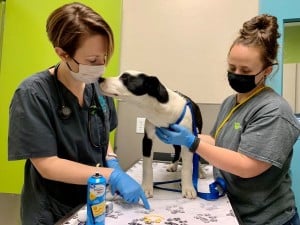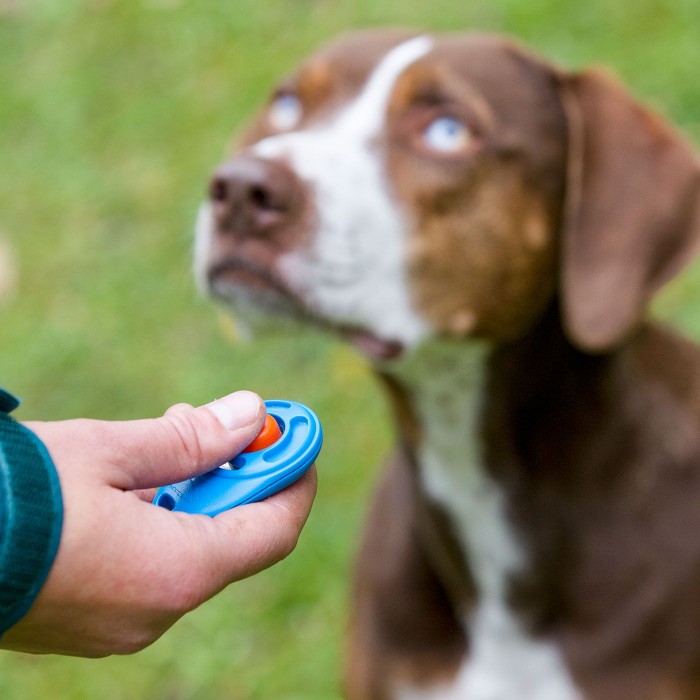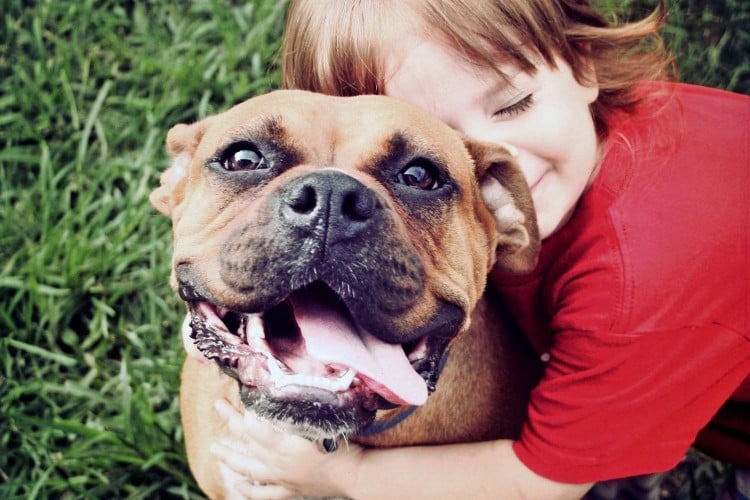
Your good girl is showing all the signs of becoming a mama—she's nesting, her nipples are swollen, maybe her belly is big. It's certainly possible that she's actually pregnant. However, it could be a common syndrome called false pregnancy.
False pregnancy in dogs looks just like regular pregnancy, but there are no actual puppies developing in her uterus. If you know for certain that your dog has not mated, then this is the most likely reason for the physical and behavioral changes you're seeing.
What Is False Pregnancy in Dogs?
False pregnancy in dogs is pretty much what it sounds like: an unspayed female dog shows signs of pregnancy when she is not actually pregnant. Other names for this syndrome include pseudopregnancy, pseudocyesis, pseudogenetra, phantom pregnancy, and nervous lactation.
During false pregnancy, hormones cause the body to mimic pregnancy even though conception has not taken place. This is a common occurrence in unspayed female dogs and can happen whether or not she has mated with a male.
To understand false pregnancy, you have to understand the female dog's reproductive system, which is controlled by hormones produced in the pituitary gland and the ovaries. Hormones are chemical messengers that tell the body what to do, and the primary ones involved in false pregnancy are estrogen, progesterone, and prolactin.
As early as 6 months of age, intact (unspayed) female dogs experience puberty and begin having heat cycles. Each cycle has four stages: proestrus, estrus, diestrus, and anestrus.
Proestrus
Proestrus is a period of vaginal bleeding or discharge that most people call "heat." It lasts about nine days and leads up to estrus, the fertile stage.
Estrus
One to two days into estrus, estrogen levels drop and progesterone levels rise. This stimulates ovulation and prepares the dog's body for pregnancy. If the eggs are not fertilized, they die within a few days. If she's actually pregnant, she'll have her puppies about 62 to 65 days after conception.
Diestrus
Diestrus begins after estrus and lasts about 60 days, whether or not the dog is pregnant. Hormonally speaking, diestrus and pregnancy are quite similar. Diestrus itself is considered "covert" pseudopregnancy—the changes occurring inside the body are similar to pregnancy, but the dog is not showing signs of pregnancy.
The progesterone hormone peaks around day 15–30 of diestrus, stimulating uterine enlargement, then begins to decline until it reaches a low point around the 60-day mark. The fall of progesterone triggers a rise in prolactin, a mammary-stimulating hormone. It's normal for dogs at this stage to have swollen nipples, even when there is no pregnancy. But if the dog is pregnant, she should have her puppies within a few days.
Anestrus
Next comes anestrus, a period of uterine repair and rest that lasts about 5-7 months. This occurs between diestrus and proestrus, even if puppies were born.
Sometimes, at the end of diestrus, prolactin levels rise more than they should in non-pregnant dogs, tricking the body into thinking that puppies are definitely on the way. During this "overt" pseudopregnancy, dogs can experience everything that comes with real pregnancy ... except for actual puppies.
Symptoms of False Pregnancy
The signs of false pregnancy in dogs are similar to the signs of late pregnancy and the early postpartum period. If you track your dog's cycle, you can expect signs to become more prominent towards the end of diestrus. You may notice physical and behavioral changes that range from mild to severe, including:
- Restlessness/pacing
- Poor appetite
- Lethargy or decreased activity
- Aggression
- Licking her belly/breasts (sometimes even self-nursing)
- Nesting
- "Mothering" objects or baby animals
- Weight gain
- Mammary enlargement/swollen nipples
- Milk secretion or discharge from the nipples
- Abdominal contractions
Less-common signs include vomiting, diarrhea, increased thirst and urination, and a ravenous appetite. False pregnancy in dogs is usually not a dangerous condition, but prolonged lactation may lead to mammary infections.
The Surprising Signs of Mastitis in Dogs (and How to Help Your Nursing Dog Feel Better)
False Pregnancy vs. Real Pregnancy
So how can you tell if your dog is experiencing a false pregnancy and isn't actually pregnant? If you are absolutely certain that your girl did not mate with a male, then it's probably a false pregnancy. However, both males and females will go to great lengths to mate when the female is in heat, so it's possible that a secret rendezvous happened behind your back. You'll need to visit your vet to be sure, because it's not something you can see with the naked eye. It's also important for your vet to rule out serious conditions like pyometra.
Your vet can determine whether or not your dog is pregnant through a few different methods:
- The simplest way is to run a canine pregnancy test. This looks for the presence of relaxin, a hormone that's only present when there's a true pregnancy. A relaxin test can reveal pregnancy in the early stages.
- If your dog is further along in her pregnancy or pseudopregnancy (about 20–22 days in), your vet can do an ultrasound to look for fetuses.
- By day 28, the vet should be able to feel pups in her abdomen if she's pregnant.
- By day 52, the puppies can be seen on abdominal X-rays.
What Causes False Pregnancies in Dogs?
The exact cause of false pregnancy in dogs isn't fully understood. The female canine reproductive cycle is designed for a pregnancy to occur at each estrus phase. All of her hormones are working together, "expecting" a pregnancy to happen. Sometimes, it seems, these chemical messages get their signals crossed and behave as if there are really puppies developing in the uterus.
Anything that causes a fall in progesterone can lead to false pregnancy. It may occur after spay surgery if the dog has already reached puberty. This can be avoided by spaying dogs before they begin their first heat cycle (ideally before 6 months of age). Dogs receiving progesterone therapy may experience false pregnancy after treatment is stopped.
How Do You Treat False Pregnancy?
The typical treatment for false pregnancy in dogs is actually no treatment at all. Most false pregnancies resolve on their own within 2–3 weeks. However, it's important to see your veterinarian for diagnosis and treatment recommendations. Dogs with severe symptoms may need medications to reduce lactation. Tranquilizers and sedatives may help in cases where the dog is stressed or anxious.
There are also some steps you can take at home to help your dog through a false pregnancy. Above all—keep your dog from licking her abdomen and nipples, as this will increase lactation. Some dogs need to wear a cone to keep them from licking the area.
As tempting as it may seem, don't try to milk the mammary glands or apply heat or cold packs to the area. Your vet may advise an abdominal wrap to apply pressure and reduce lactation. Temporary water reduction may reduce lactation due to borderline dehydration, but this is risky and should only be done under a vet's direct supervision.
If you don't plan to breed your dog, spaying is recommended to keep a phantom pregnancy from happening again. Because spaying during a false pregnancy can prolong the signs, most vets advise waiting to spay until after the signs subside.
How Much Does It Cost to Spay or Neuter a Dog?





